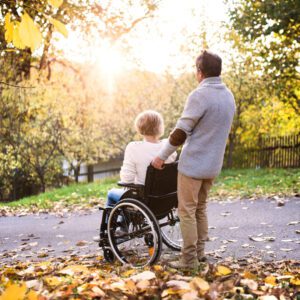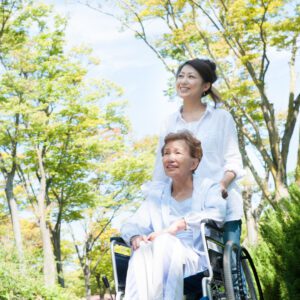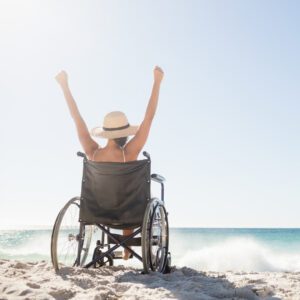The blind spot of making travel barrier-free
Table of contents
1. Room for improvement in social inclusion in the travel industry
2. What difficult-to-move people such as the disabled and the elderlyare most dissatisfied with
3. Everyone will eventually become difficult-to-move people
4. Visible barrier-free progress, but invisible barriers remain
5. Let’s remove the invisible barrier together
1. Room for improvement in social inclusion in the travel industry
On September 7th, we posted our opinion on “Environmentally Friendly Travel” in Expedia’s “Traveler Value Index”.
This time, in the “Traveler Value Index“, “Values on Respect and Equality of Individuals”, “nearly two-thirds of travelers (65%) say they are more willing to book accommodations that have policies focused on diversity and inclusion.” I would like to give our opinion on the answer.
According to the explanation of the Ministry of Health, Labor and Welfare of Japan, social inclusion is a philosophy that protects all people from loneliness, isolation, exclusion and friction, and wraps and supports them as members of society for the realization of a healthy and cultural life.
Certainly, the idea of social inclusion will be affirmed by many people. However, when traveling, there are many “difficult-to-move people” such as the disabled and the elderly. “difficult-to-move people” may feel “lonely or isolated” because it is difficult to travel. Therefore, social inclusion has a lot of room for improvement in the travel industry. We believe that not only the removal of the “visible” barrier, but also the awareness and removal of the “invisible” barrier will not eliminate the “loneliness and isolation” of the “difficult-to-move people”.
2. What difficult-to-move people such as the disabled and the elderlyare most dissatisfied with
I would like to introduce an interesting paper about “difficult-to-move people”. This is a paper entitled “Universal Tourism for difficult-to-move people” (authors: Tetsuo Akiyama, Yasuhiro Onishi, Takayuki Sato).

According to this paper, in the questionnaire to difficult-to-move people, “I am most dissatisfied with travel products”, the first place is “price” 38%, and the second place is “attractiveness of tour contents” and “accommodation facilities”. Barrier-free support ”is 24%. Isn’t it surprising that difficult-to-move people are dissatisfied with the “price” that comes higher than the dissatisfaction with the hardware side?
According to the paper, the reason for dissatisfaction with “price” is that “the fare for people who have difficulty traveling is about double for general tourism.” Travel costs for difficult-to-move people are overwhelmingly high. In this paper, Mr. Akiyama’s mother with a disability is given as an example. Transportation expenses, accommodation expenses, etc. However, in my opinion, if you have two attendants, the fare for difficult-to-move people will be tripled, not doubled. There was no explanation in the paper that the travel fee would be doubled.
In any case, the need for caregiving and other factors increase the cost of travel, which is the biggest dissatisfaction with travel products for difficult-to-move people.

In this paper, it is argued that travel costs can be significantly reduced by making caregivers “locally procured”. It means that it is cheaper to have a caregiving only at the destination than to have a caregiving for the entire travel itinerary. That’s true. However, local procurement of caregivers means that difficult-to-move people have to move to their travel destinations on their own. Therefore, it is expected that it will be quite difficult to carry large luggage by themselves, which is carried by difficult-to-move people such as the disabled and the elderly. For domestic travel, they can send their luggage to their destination, so there is no problem. However, when traveling abroad, it is not realistic to send their luggage to their destination.
I believe that the presence of large luggage that they have to carry when traveling abroad makes it difficult for caregivers to “procure locally”. Therefore, by locally procuring not only “local procurement” of “people (caregivers)” but also “clothing and travel goods” required at the travel destination, it is possible to significantly reduce the travel price of difficult-to-move people such as the disabled and the elderly. I think more difficult-to-move people will be able to enjoy the trip. By doing this, we believe that we can approach the realization of our mission of “creating a world where everyone can travel easily.”
In JTB’s “Annual Travel Report 2020”, “High travel charges” (24.5% of the answers) is the third most important factor in not being able to travel abroad in a questionnaire to the general public. Even if you are not difficult-to-move people, you are dissatisfied with the overseas travel fare. It is not surprising that difficult-to-move people who have high travel costs are dissatisfied with the travel costs.

3. Everyone will eventually become difficult-to-move people
Currently, I am not a difficult person to move. As a percentage of the population, many travel lovers are not difficult to move. However, everyone will eventually become elderly, and one day they may suddenly become difficult-to-move people due to an accident. If you are an elderly person living alone, it is difficult for a family member living apart to travel as a caregiving person. Therefore, going on a trip requires a caregiver other than the family, so you have to pay a large amount of travel fee as mentioned above. In that case, elderly people who liked traveling when they were young will have considerable stress because they can travel less often or cannot travel. In the end, creating a travel environment that does not require a high travel fee even for difficult-to-move people will be useful to everyone.
4. Visible barrier-free progress, but invisible barriers remain
The “Tourism Barrier-Free Manual” of Okinawa Prefecture was very easy to understand about barrier-free and universal design, so I will excerpt it.
“Barrier-free” refers to the idea of removing barriers for the elderly and people with disabilities. “Universal design” refers to products and services that are easy for everyone to use, regardless of gender, age, nationality, or disability. The basics of barrier-free are (1) to be aware of the “barrier”, (2) to have the feeling of removing the “barrier”, and (3) to actually remove the “barrier”. It’s very simple and anyone can easily practice it anytime, anywhere.
As for barrier-free, passenger facilities are becoming more barrier-free. According to the Ministry of Land, Infrastructure, Transport and Tourism, at railway stations, bus terminals, passenger ship terminals, and air passenger terminals, “installation of blocks for guiding the visually impaired”, “elimination of steps”, and “toilet for the elderly with disabilities (barrier-free toilets)” ) Installation ”has made great progress in the last 20 years. In particular, the introduction rate of “barrier-free toilets” increased from only 0.1% at the end of 2000 to 88.6% at the end of 2019. “Elimination of steps” has improved significantly from 28.9% at the end of 2000 to 91.9% at the end of 2019.
However, until now, Japanese society has noticed and removed “visible” barriers such as steps, but in the future it will be necessary to notice and remove “invisible” barriers. Otherwise, we will not be able to resolve the “high travel costs” that are the biggest complaints of difficult-to-move people such as the disabled, as mentioned in the previous paper.
To reiterate, we can reduce of expensive travel prices, which is an “invisible” barrier, is not only by “local procurement” of “caregivers” but also by “local procurement” of “necessary items for travel”.
Recognizing and removing the biggest complaints of difficult-to-move people ultimately leads to universal design and universal travel, which are easy-to-use products and services for everyone.
In addition, as I posted earlier, procuring “what you need at your travel destination” locally leads to the following merits. You don’t have to pay the checked baggage fee to the LCC, you can reduce the travel price, and not loading a large baggage on the plane greatly reduces CO2 emissions.
5. Let’s remove the invisible barrier together
The 2021 White Paper on Aging Society estimates that 15.5% of the elderly living alone (65 years old and over) will live alone in 2020, and will reach 20.8% by 2040.
It is important to create a world where universal tourism and barrier-free tourism are commonplace, in case we or our family become difficult to move.
Isn’t that the idea of social inclusion in the travel industry as well, to realize the idea of ”wrapping and supporting all people as members of society”?
At the beginning, we introduced the survey results that “nearly two-thirds of travelers (65%) say they are more willing to book accommodations that have policies focused on diversity and inclusion.” In order to meet the needs of users (travelers), the travel industry should work together to reduce the travel price, which is the biggest complaint of difficult-to-move people.
On the other hand, I would like travelers to actively use travel-related companies that “implement social inclusion.” In a world where universal tourism and barrier-free tourism are commonplace, it cannot be left to others. First, let’s act ourselves.
